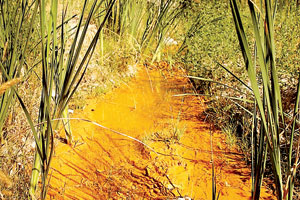The U.S. Environmental Protection Agency plans to start work
on
”
short-term
”
solutions this fall at the contaminated, abandoned New Idria
mercury mine, said the agency’s project manager overseeing the
cleanup.
The U.S. Environmental Protection Agency plans to start work on “short-term” solutions this fall at the contaminated, abandoned New Idria mercury mine, said the agency’s project manager overseeing the cleanup.
The EPA recently announced the San Benito County site is on the Superfund list of priorities, opening the door for federal involvement and funding. The project manager for the New Idria mine, Kelly Manheimer, noted that the agency expects to start abatement there in the fall, starting with short-term solutions that should curtail some of the pollution.
“First, we’re putting in some fencing around some of the more dangerous parts of the site, where we do not want people entering,” she said.
She stressed that one of the “main problems” of the site is that acidic water seeps from the mine and flows over waste piles, picking up more mercury and dumping it into San Carlos Creek. The EPA plans to capture the water before the waste piles and run the pipe to a settling pond. There used to be a settling pond at the mine, and the agency plans to use one again. It will allow the sediment to settle out, while the EPA will construct “some sort of neutralization system” for the acidity.
She said the concern is a combination of high mercury levels, an abundance of sediment and low pH.
“We can address all three of those, at least to some extent, instead of letting it run freely,” Manheimer said.
In discussing prospects for the long term, she explained the Superfund process – which involves first investigating the extent of the problem, then doing a series of evaluations to find a remedy, and finally implementing the plan. The process normally takes five to 10 years for an abatement, she said.
The EPA still must finish an analysis of who is considered responsible, the owner or owners of the property when it was abandoned. Manheimer said the agency did not want to wait, though, while it had funds available and is trying to get the work started in the fall. The cost for the short-term abatement is estimated at about $500,000, she said.
She underscored that many other agencies tried to deal with the site, but could not find a way to address the problems.
“The EPA is in a position to go ahead and take care of these types of sites,” she said. “That is why the EPA is here. It’s what we do well.”










